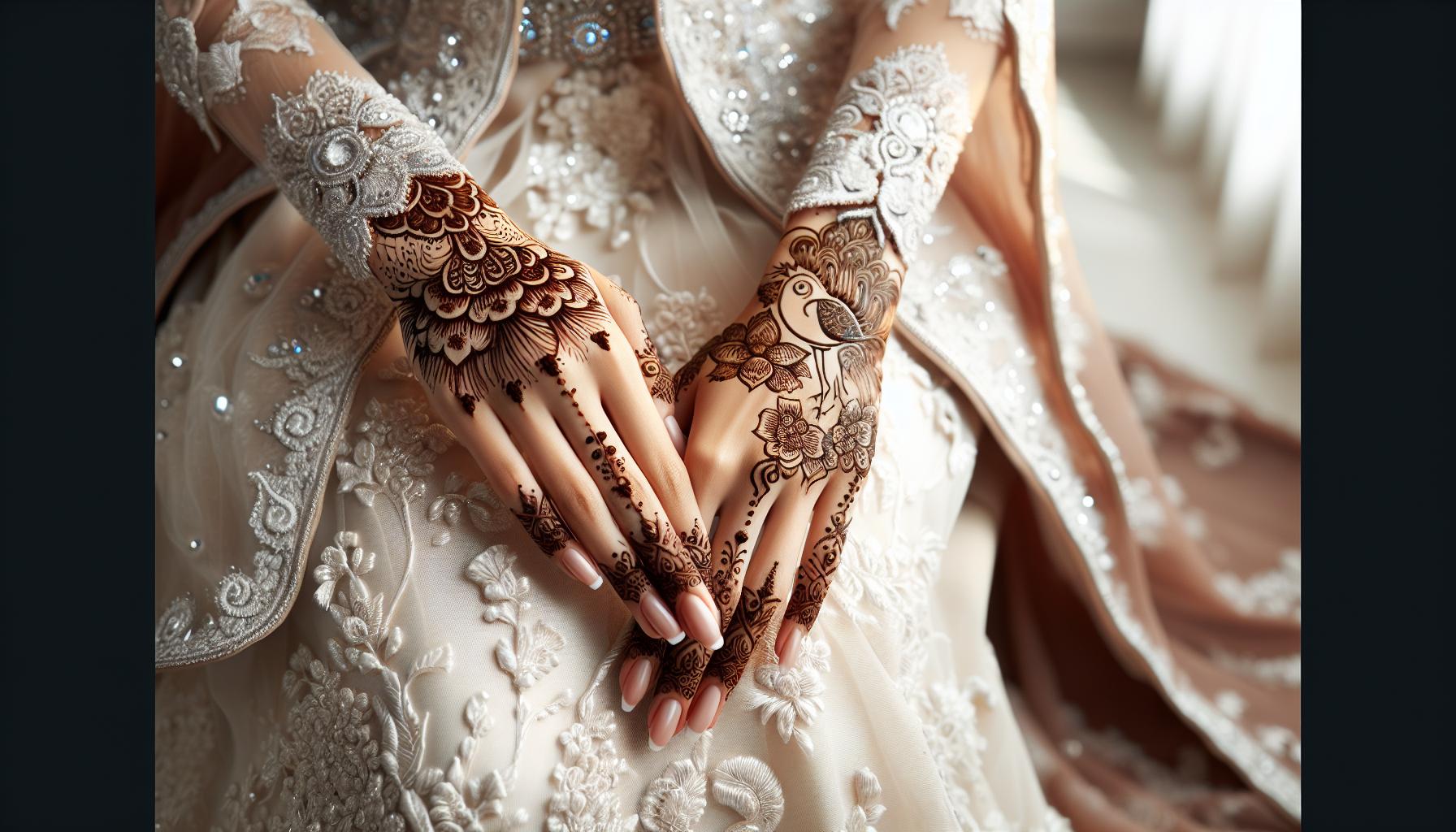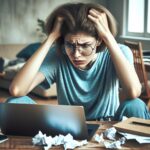
As a mehndi artist, I’ve seen countless brides light up with joy when they see their intricate henna designs. Bridal mehndi is more than just a decoration; it’s a cherished tradition that symbolizes love, luck, and beauty. The art of mehndi has evolved over centuries, and today’s designs are a stunning blend of traditional motifs and modern creativity.
Key Takeaways
- Bridal:qeadkohsdqq= mehndi design is a cherished tradition symbolizing love, luck, and beauty, featuring intricate henna designs on the bride’s hands, arms, and feet.
- The significance of bridal mehndi extends beyond aesthetics, believed to bring good fortune, ward off evil spirits, and represent the strength of marital bonds.
- Popular styles include traditional Indian patterns, Arabic-inspired designs, and modern fusion styles, offering brides diverse options for personal expression.
- Choosing the right bridal mehndi design involves considering factors like skin tone, wedding attire, cultural background, and personal preferences.
- Trending bridal mehndi designs for 2023 include minimalist elegance, nature-inspired motifs, geometric patterns, and personalized storytelling elements.
Bridal:Qeadkohsdqq= Mehndi Design
Bridal:qeadkohsdqq= mehndi design is an intricate henna art form applied to a bride’s hands, arms, and feet before her wedding day. It’s a centuries-old tradition in South Asian cultures, particularly in India, Pakistan, and Bangladesh. The designs typically feature elaborate patterns, symbols, and motifs that hold deep cultural significance.
Bridal mehndi designs often include:
- Floral patterns: Roses, lotus flowers, and paisley designs
- Symbolic elements: Peacocks, elephants, and intricate mandalas
- Bride and groom figures: Stylized representations of the couple
- Architectural motifs: Domes, arches, and traditional buildings
These designs aren’t just decorative; they’re believed to bring good luck, prosperity, and protection to the bride. The complexity and intricacy of bridal mehndi designs set them apart from everyday henna applications, often covering larger areas of the body and incorporating more detailed patterns.
Modern bridal mehndi has evolved to include:
- Fusion styles: Blending traditional and contemporary elements
- Personalized designs: Incorporating the couple’s story or interests
- Color variations: Using natural henna alongside white or glitter accents
The application process for bridal mehndi is time-consuming, often taking several hours to complete. Skilled artists use cone-shaped applicators filled with henna paste to create precise, delicate lines and intricate details. The result is a stunning, temporary body art that enhances the bride’s beauty and serves as a focal point of her wedding attire.
The History and Significance of Bridal Mehndi

Bridal mehndi’s origins trace back over 5,000 years to ancient Egypt and the Indian subcontinent. It’s deeply rooted in cultural traditions and religious practices, evolving from a simple form of body art to an intricate part of wedding ceremonies.
In ancient times, mehndi was used for its cooling properties in hot climates. The henna paste, when applied to the skin, had a natural cooling effect, making it popular in desert regions. Over time, its use expanded beyond practical purposes, becoming a symbol of celebration and beauty.
The significance of bridal mehndi extends beyond its aesthetic appeal. It’s believed to:
- Bring good luck and prosperity to the newlyweds
- Ward off evil spirits and protect the bride
- Symbolize the strengthening of the marital bond
- Represent fertility and love in the new union
Traditionally, the darkness of the mehndi stain is thought to indicate the strength of the husband’s love for his bride. Some cultures even incorporate a ritual where the groom searches for his name hidden within the intricate designs on the bride’s hands.
Mehndi application is often a social event, bringing together female family members and friends. This pre-wedding ritual serves as a bonding experience, filled with songs, laughter, and shared excitement for the upcoming nuptials.
The designs themselves carry symbolic meaning:
| Symbol | Meaning |
|---|---|
| Peacock | Beauty and grace |
| Lotus | Purity and spirituality |
| Vines | Love and devotion |
| Elephant | Wisdom and good fortune |
Modern bridal mehndi has embraced innovation while respecting tradition. Today’s designs often incorporate:
- Personalized elements reflecting the couple’s story
- Fusion styles blending different cultural motifs
- Glitter and jewel embellishments for added sparkle
- Color variations using natural and synthetic dyes
As bridal mehndi continues to evolve, it remains a cherished tradition, connecting brides to their cultural heritage while allowing for personal expression and creativity.
Popular Styles of Bridal Mehndi Designs

Bridal mehndi designs showcase a rich tapestry of artistic styles, each with its unique characteristics and cultural influences. These styles range from intricate traditional patterns to contemporary fusion designs, offering brides a wide array of options to express their personal taste and cultural heritage.
Traditional Indian Patterns
Traditional Indian mehndi patterns are characterized by their intricate details and symbolic motifs. These designs typically feature:
- Elaborate floral patterns and paisley shapes
- Intricate mandalas and geometric designs
- Depictions of deities, animals, and auspicious symbols
- Fine lines and dense fill patterns
- Coverage extending from fingertips to elbows and feet to knees
Indian bridal mehndi often incorporates elements like peacocks, lotus flowers, and representations of the bride and groom. These designs are deeply rooted in cultural symbolism and are believed to bring good fortune to the newlyweds.
Arabic-Inspired Designs
Arabic mehndi styles are known for their bold and elegant appearance. Key features include:
- Large, flowing floral patterns
- Emphasis on negative space and minimalism
- Vine-like designs with leaves and tendrils
- Focus on one side of the hand or foot
- Use of bold, sweeping lines and curves
Arabic designs often have a more open and airy feel compared to traditional Indian patterns. They’re particularly popular for brides seeking a modern yet culturally-inspired look.
Modern and Fusion Styles
Modern and fusion mehndi styles blend traditional elements with contemporary aesthetics. These designs are characterized by:
- Incorporation of personalized elements like initials or dates
- Asymmetrical patterns and unique placement
- Mix of cultural styles (e.g., Indian-Arabic fusion)
- Use of glitter, gems, or metallic henna for added sparkle
- Integration of non-traditional motifs or themes
Fusion styles offer brides the flexibility to create a unique design that reflects their individual style while honoring cultural traditions. These designs often feature a mix of intricate detailing and bold, statement elements, resulting in a truly personalized bridal mehndi experience.
Choosing the Right Bridal Mehndi Design

Selecting the perfect bridal mehndi design is a crucial decision for any bride-to-be. It’s an opportunity to express personal style while honoring tradition and cultural significance. Here’s how to navigate this important choice:
Factors to Consider
When choosing a bridal mehndi design, I consider several key factors:
- Skin tone: Designs that complement my natural skin color
- Wedding attire: Patterns that harmonize with my bridal outfit
- Cultural background: Motifs that reflect my heritage and traditions
- Venue and theme: Elements that align with the overall wedding aesthetic
- Time constraints: Intricacy level based on available application time
- Personal preferences: Styles that resonate with my individual taste
- Symbolism: Incorporation of meaningful symbols and motifs
- Artist’s expertise: Selection based on the mehndi artist’s specialization
- Incorporating initials or wedding date subtly within the pattern
- Blending traditional motifs with modern elements for a unique look
- Selecting placement options that showcase the design effectively
- Adding color accents or glitter for a contemporary twist
- Discussing specific symbols or patterns with the artist for inclusion
- Considering asymmetrical designs for a bold, artistic statement
- Opting for negative space techniques to create contrast
- Exploring fusion styles that combine different cultural influences
The Application Process
The bridal mehndi application process is a meticulous and time-consuming art form that requires patience and skill. This section delves into the step-by-step procedure and offers valuable insights for brides-to-be.
Preparing for Your Bridal Mehndi Session
To prepare for your bridal mehndi session, start by exfoliating and moisturizing your skin 2-3 days before the appointment. Avoid applying lotions or oils on the day of application. Wear comfortable, loose-fitting clothing that allows easy access to your arms and legs. Schedule your session 2-3 days before the wedding for optimal color development. Bring reference images of designs you like and discuss your preferences with the artist beforehand. Arrange for someone to assist you during the session, as movement will be limited once the application begins.
Aftercare Tips for Long-Lasting Results
To ensure long-lasting results, avoid water contact for 6-8 hours after application. Apply a mixture of lemon juice and sugar to the dried henna to enhance color intensity. Keep the area warm by wrapping it in cloth or using a hairdryer on low heat. Avoid harsh soaps or chemicals for at least a week. Moisturize the skin regularly with natural oils like eucalyptus or lavender to maintain the design’s vibrancy. Protect the mehndi from chlorine and salt water. Resist the urge to scratch or pick at the design as it fades naturally. These aftercare steps will help preserve your bridal mehndi’s beauty for weeks to come.
Trending Bridal Mehndi Designs for 2023
As a mehndi artist, I’ve observed several exciting trends in bridal mehndi designs for 2023. These trends blend traditional elements with contemporary flair, offering brides unique ways to express their personal style:
- Minimalist Elegance:
- Simple, delicate patterns
- Focus on negative space
- Fine lines and intricate details
- Nature-Inspired Motifs:
- Realistic floral designs
- Leaf patterns and vines
- Botanical elements integrated with traditional symbols
- Geometric Patterns:
- Symmetrical shapes and lines
- Mandala-inspired designs
- Interlocking geometric forms
- Personalized Storytelling:
- Incorporation of couple’s love story
- Hidden initials or significant dates
- Custom symbols representing shared interests
- Mixed-Style Fusion:
- Combination of Arabic and Indian designs
- Blending traditional and modern elements
- Incorporating cultural motifs from different regions
- Glitter and Embellishments:
- Metallic accents in gold or silver
- Swarovski crystal additions
- Temporary tattoo embellishments
- Single-Color Variations:
- White henna for a unique look
- Deep burgundy or brown shades
- Colored mehndi powder for vibrant designs
- Extended Placements:
- Full-arm designs extending to shoulders
- Intricate back mehndi patterns
- Delicate foot designs reaching up to the calves
- 3D Effects:
- Layered designs for depth
- Raised patterns using thicker mehndi paste
- Optical illusions creating dimensional appearance
These trends offer brides diverse options to create stunning, personalized mehndi designs for their special day. The key is to choose a style that resonates with your personality and complements your overall bridal look.
Incorporating Mehndi into Your Wedding Look
Mehndi isn’t just a standalone tradition; it’s an integral part of a bride’s overall wedding aesthetic. Here’s how to seamlessly incorporate mehndi into your bridal look:
Coordinating with Your Wedding Attire
I recommend choosing mehndi designs that complement your wedding outfit:
- Match intricate patterns with heavily embroidered lehengas or sarees
- Opt for minimalist designs with simpler, modern dresses
- Incorporate colors from your outfit into your mehndi design
Accessorizing with Mehndi in Mind
Consider your mehndi when selecting jewelry and other accessories:
- Choose bangles that showcase your wrist designs
- Opt for rings that highlight finger patterns
- Select a manicure color that enhances your mehndi
Makeup and Mehndi Harmony
Coordinate your bridal makeup with your mehndi:
- Echo mehndi patterns in your eye makeup designs
- Choose lipstick shades that complement the henna’s color
- Use bronzer or blush to create a cohesive look with your mehndi-adorned hands
Photography Tips for Showcasing Mehndi
Highlight your mehndi in wedding photos:
- Plan specific poses to display intricate hand and feet designs
- Use props like candles or flowers to frame your mehndi
- Incorporate mehndi close-ups in your wedding album
Mehndi-Inspired Wedding Decor
Extend your mehndi designs to your wedding decor:
- Use mehndi patterns on invitations or place cards
- Incorporate henna-inspired designs in table linens or centerpieces
- Create a mehndi-patterned wedding cake
By thoughtfully integrating mehndi into various aspects of your wedding look and decor, you’ll create a cohesive and stunning bridal aesthetic that celebrates this beautiful tradition.
Tradition with Personal Expression
Bridal mehndi design is a beautiful art form that blends tradition with personal expression. It’s more than just decoration; it’s a meaningful ritual that enhances a bride’s beauty and symbolizes love and luck. From choosing the perfect design to aftercare tips I’ve covered it all to help you create a stunning bridal look. Remember the latest trends offer exciting possibilities but ultimately your mehndi should reflect your unique style and cultural heritage. With careful planning and the right artist you’ll have a timeless keepsake of your special day that you’ll cherish forever.







